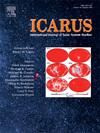Extensional structures at lunar lobate scarps
IF 2.5
2区 物理与天体物理
Q2 ASTRONOMY & ASTROPHYSICS
引用次数: 0
Abstract
The Moon's lithosphere has been in a net compressional stress regime for the past 3.6 billion years, leading to the formation of globally distributed kilometer-scale thrust faults that form lobate scarps at the surface. Lobate scarps are among the youngest features on the lunar surface. A sign of their recent activity is the presence of meter-scale extensional structures in their hanging walls, which are generally either parallel or perpendicular to the scarp-forming thrust fault. However, the origin of these structures and their orientation relative to the primary fault is not well understood. Here, we present detailed tectonic maps of three lobate scarps (Lee-Lincoln, Lilius C-1, and Morozov-1), which reveal sets of fault-perpendicular to fault-parallel extensional structures at all scarps. Using high-resolution digital elevation models, we measure along-strike variations in fault throw and document maximum throws of ∼216 m for Lee-Lincoln, ∼98 m for Lilius C-1, and ∼140 m for Morozov-1. By comparison with terrestrial analogs, we show that fault-parallel extensional structures are mainly formed by flexural bending of the hanging wall, whereas fault-perpendicular features are potentially formed by along-strike variations in thrust orientation, and potential strike-slip components on the thrust fault. We hypothesize that small extensional structures preferably either form near the main displacement, at the most recently active regions of a scarp, or at segment boundaries. Based on degradation-rate estimates, we propose that small graben provide the best evidence for very recent activity of lobate scarp faults, because the graben form during coseismic slip events on the thrust faults.
求助全文
约1分钟内获得全文
求助全文
来源期刊

Icarus
地学天文-天文与天体物理
CiteScore
6.30
自引率
18.80%
发文量
356
审稿时长
2-4 weeks
期刊介绍:
Icarus is devoted to the publication of original contributions in the field of Solar System studies. Manuscripts reporting the results of new research - observational, experimental, or theoretical - concerning the astronomy, geology, meteorology, physics, chemistry, biology, and other scientific aspects of our Solar System or extrasolar systems are welcome. The journal generally does not publish papers devoted exclusively to the Sun, the Earth, celestial mechanics, meteoritics, or astrophysics. Icarus does not publish papers that provide "improved" versions of Bode''s law, or other numerical relations, without a sound physical basis. Icarus does not publish meeting announcements or general notices. Reviews, historical papers, and manuscripts describing spacecraft instrumentation may be considered, but only with prior approval of the editor. An entire issue of the journal is occasionally devoted to a single subject, usually arising from a conference on the same topic. The language of publication is English. American or British usage is accepted, but not a mixture of these.
 求助内容:
求助内容: 应助结果提醒方式:
应助结果提醒方式:


